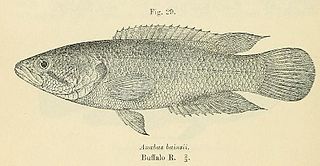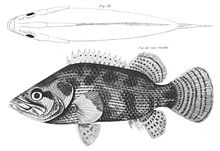
Leaffishes are small fishes of the family Polycentridae. According to FishBase, it only includes the genera Monocirrhus and Polycentrus from fresh and brackish water in tropical South America. Although included in the Asian leaffish family Nandidae by FishBase, most recent authorities place the African Afronandus and Polycentropsis in Polycentridae. Polycentridae were formerly placed in the order Cichliformes but are now regarded as being incertae sedis in the subseries Ovalentaria in the clade Percomorpha.
Leaf fish or Leaffish may refer to:

Trichogaster is a genus of gouramis native to South Asia from Pakistan to Myanmar. It is the only genus in the monotypic subfamily Trichogastrinae as set out in the 5th Edition of Fishes of the World, although that book states that there are two genera, the other being Colisa which is treated as a synonym of Trichogaster by Fishbase and the Catalog of Fishes. Fishbase also places the genus in the Luciocephalinae. Species of this genus are very popular in the aquarium trade.
Betta chini is a species of gourami endemic to the island Borneo where it is only known from the Malaysian state of Sabah. It inhabits very shallow waters of peat swamps. Males of this species can reach a length of 5.1 centimetres (2.0 in) SL while females can reach a length of 5.6 centimetres (2.2 in). The specific name of this fish honours the Malaysian ichthyologist Chin Phui-Kong.

The ornate paradisefish or spotted gourami, is a species of gourami endemic to Sri Lanka. It inhabits shallow, slow-flowing streams in forested areas shaded with plentiful vegetation near the edges and a substrate covered by leaf litter. It is a carnivore, preying on plankton, fish fry, and the larvae of insects. They can reach a length of 4 cm (1.6 in), though most are only around 2 cm (0.79 in). This species can also occasionally be found in the aquarium trade, where it is reportedly exceedingly shy. The specific name of this fish honours the Sri Lankan lawyer and judge Oswald Leslie De Kretser II.
Microctenopoma damasi is a species of fish in the family Anabantidae. It is found in the Democratic Republic of the Congo and Uganda. Its natural habitat is rivers. This species was formally described in 1939 as Anabas damasi by the Belgian ichthyologist Max Poll, the type locality given was Semliki River at Ishango in the Democratic Republic of Congo. The type was collected by Hubert Damas (1910-1964) of the University of Liège and when he described the species Poll named Damas as co-author, this meant that Damas was the co-author of a specific name which honoured himself.

The Eastern Province rocky, also known as rocky kurper, is a species of fish in the family Anabantidae. It is endemic to South Africa.

Betta enisae is a species of gourami endemic to the Kapuas River basin of Indonesia. It is an inhabitant of forest streams with slightly acidic waters, and can mostly be found in the shallows amongst the leaf litter. This species grows to a length of 5.9 cm (2.3 in). It is commonly used as bait by local fishermen and has been found in the aquarium trade. The specific name of this fish honours Enis Widjanarti who assisted Kottelat in his expedition to the Kapuas Lakes.

Betta edithae is a species of gourami endemic to Indonesia where it occurs in Kalimantan, Sumatra and the Riau Archipelago. This species grows to a length of 8.2 cm (3.2 in), and can be found in the aquarium trade. The specific name honours the German aquarist Edith Korthaus (1923-1987), who co-discovered this species with her husband Walter Foersch. Walter is honoured in the specific name of another species they discovered, Betta foerschi.
Betta waseri is a species of gourami endemic to Peninsular Malaysia. It is an inhabitant of well shaded blackwater streams and in peat forests with plentiful organic debris and root growth. This species grows to a length of 9.8 centimetres (3.9 in) SL. The specific name honours the leader of the expedition on which the type of this species, the German aquarist Alfred Waser.

The Badidae are a small family which has been placed in the order anabantiforme fishes. However, the 5th edition of Fishes of the World classifies the family as being a sister to the Anabantiformes, along with the Nandidae and Pristolepididae in an unnamed and unranked but monophyletic clade which is a sister to the Ovalentaria within the wider Percomorpha. Members of this family are small freshwater fish that are found in Bangladesh, Bhutan, China, India, Laos, Myanmar, Nepal, Pakistan and Thailand. The largest is Badis assamensis that reaches a standard length of up to 7.5 cm (3 in), while the smallest, Dario dario, does not exceed 2 cm (0.8 in).
The fourspine leaffish, is a species of in the Nandidae native to rivers and streams in Ivory Coast and Ghana. Although placed in the family Nandidae by FishBase, most recent authorities place Afronandus in Polycentridae. The specific name honours the collector of the type, Leo Sheljuzhko (1890–1969), a Ukrainian-German entomologist who sent the type to Meinken.

the African leaffish is a species of African leaffish native to fresh waters of western Africa. Although placed in the family Nandidae by FishBase and by the 5th Edition of Fishes of the World many recent authorities place Polycentropsis in Polycentridae.

The Amazon leaffish, or South American leaffish, is a species of fish belonging to the family Polycentridae. It is found in the Amazon basin in Bolivia, Brazil, Colombia, Peru and Venezuela, where it inhabits edges of rivers and lakes, and streams. It is generally a low-density species that lives in slow-moving or essentially stagnant waters in areas with plant debris.
Pristolepis grootii, commonly known as the Indonesian leaffish, is a fish native to streams of the Indonesian islands of Sumatra, Bangka, Belitung and Borneo, and Thailand. It is part of the first Western Indonesian and Sulawesi Freshwater fish species recorded by December 31, 1991 along with another 963 species. Further research lead to the discovery of other 79 fish species in the area. By May 31st, 1996 deletions and additions were made revealing a grand total of 1032 known fish species in the area. The specific name honours the Dutch naturalist and ethnographer Cornelis de Groot van Embden (1817-1896).

Pristolepis is a genus of fish in the family Pristolepididae sometimes classified in the order Anabantiformes native to freshwater habitats in Southeast Asia and India's Western Ghats. This genus is the only member of its family, a family which, with the families Nandidae and Polycentridae is a group of taxa which are sisters to the Anabantiformes and form part of an unnamed and unranked clade within the series Ovalentaria, closest to the Carangiformes. These three families share the common name "leaffish".

The Anabantiformes are an order of freshwater ray-finned fish with two suborders, five families and having at least 207 species. In addition, some authorities expand the order to include the suborder Nandoidei, which includes three families - the Nandidae, Badidae and Pristolepididae - that appear to be closely related to the Anabantiformes. The order, and these three related families, are part of a monophyletic clade which is a sister clade to the Ovalentaria, the other orders in the clade being Synbranchiformes, Carangiformes, Istiophoriformes and Pleuronectiformes. This clade is sometimes referred to as the Carangaria but is left unnamed and unranked in Fishes of the World. This group of fish are found in Asia and Africa, with some species introduced in United States of America.
Channa stewartii is a species of dwarf snakehead in the family Channidae, which is native to Nepal and the Indian states of Arunachal Pradesh, Assam, Manipur, Meghalaya, Nagaland and Tripura. It may also be found in Bangladesh. This freshwater fish mostly inhabits hill streams, but can also be found in ponds. It is of little value as a food fish but common in the aquarium trade.
Trichopodus poptae is a species of ray-finned fish in the subfamily Luciocephalinae, part of the gourami family Osphronemidae. It is distinguished from its congeners by the faint, almost indiscernible patterning on the body apart from the black blotch at the base of the tail. This species is endemic to Kalimantan, the Indonesian part of the island of Borneo. The specific name honours the ichthyologist Canna Maria Louise Popta (1860–1929) who was Curator of Reptiles, Amphibians and Fishes at the Rijksmuseum van Natuurlijke Historie in Leiden who was one of the earliest workers on Borneo's freshwater fishes and described manty of the specimens collected on the trans-Borneo expeditions which took place between 1893 and 1900.

Pseudosphromenus dayi is a species of freshwater ray finned fish from the subfamily Macropodusinae, part of the gourami family Osphronemidae. It occurs in Kerala on both the coastal regions and the Western Ghats. It is a species of still or slow flowing waters, especially lakes, ditches and swamps in both fresh and brackish waters. Pseudosphromenus dayi is a bubble nester, the male creates a nest made of bubbles under an overhang or a leaf. The females lays eggs which drop to the substrate and are picked up by both fishes in the pair and placed in the bubble nest. The name Polyacanthus cupanus dayi was first published in 1908 by Köhler in 1908 but Catalog of Fishes refers to this as a nomen nudum and attributes the valid use of the name, with a formal description, to P. Engmann in 1909. The type locality is given as Malacca which is probably an error and should be Kerala. The specific name honors the British ichthyologist and author of the Fishes of India, Francis Day (1830–1889).












